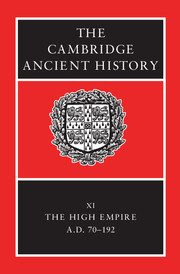Book contents
- Frontmatter
- PART I NARRATIVE
- PART II GOVERNMENT AND CIVIL ADMINISTRATION
- PART III THE EMPIRE
- PART IV ROME, ITALY AND THE PROVINCES
- 12 Rome and Italy
- 13 Spain
- 14 Gaul
- 15 Roman Germany
- 16 Africa
- 17 Cyrenaica
- 18 Britain
- 19 The Danube provinces
- 20 Greece and Asia Minor
- 21 Syria and Arabia
- 22 Judaea
- PART Va ECONOMY AND SOCIETY
- PART Vb ART AND CULTURE
- Chronological Table
- BIBLIOGRAPHY
- Index
- 1 The Roman world in the time of Marcus Aurelius
- 7 The Danube provinces
- References
12 - Rome and Italy
from PART IV - ROME, ITALY AND THE PROVINCES
Published online by Cambridge University Press: 28 March 2008
- Frontmatter
- PART I NARRATIVE
- PART II GOVERNMENT AND CIVIL ADMINISTRATION
- PART III THE EMPIRE
- PART IV ROME, ITALY AND THE PROVINCES
- 12 Rome and Italy
- 13 Spain
- 14 Gaul
- 15 Roman Germany
- 16 Africa
- 17 Cyrenaica
- 18 Britain
- 19 The Danube provinces
- 20 Greece and Asia Minor
- 21 Syria and Arabia
- 22 Judaea
- PART Va ECONOMY AND SOCIETY
- PART Vb ART AND CULTURE
- Chronological Table
- BIBLIOGRAPHY
- Index
- 1 The Roman world in the time of Marcus Aurelius
- 7 The Danube provinces
- References
Summary
THE CITY OF WONDERS AT THE HEART OF A MOBILE WORLD
In the middle of the fifth century of our era, Hierios, son of Ploutarchos, the Neoplatonist philosopher, studied at Rome with Proclus. An anecdote of his stay tells us that ‘in the house called that of Quirinus’, he was shown ‘a miniature human head, on its own, rather like a chick-pea in size and shape … but in other respects a real human head, with eyes and a face and hair on top and a complete mouth, from which came a voice like that of a thousand men, it was so loud’. Here is not the place to examine the specific context of the bizarrerie of this story; but it is an appropriate place to begin. The period under discussion should be seen as that in which Rome the late antique city was formed. The display of astonishing wonders to credulous visiting intellectuals, in the mysterious setting of the city's ancient past – Hierios' tale is set in the Temple of Quirinus – is already characteristic of the second century. It derives ultimately from the establishment under the Flavian emperors of Rome's role as a cultural capital for the whole Greco-Roman empire. In this period too, Italy, at least Italy south of the Cisalpine plain, became more than ever a backdrop to the metropolitan theatricals of Rome, and should be considered alongside its largest agglomeration.
Augustus had started the process of making Rome, as a matter of policy, a worthy capital of the world. The wonders assembled in Rome, which could be experienced on journeys there, became one of the symbolic structures of empire.
- Type
- Chapter
- Information
- The Cambridge Ancient History , pp. 405 - 443Publisher: Cambridge University PressPrint publication year: 2000
References
- 15
- Cited by

